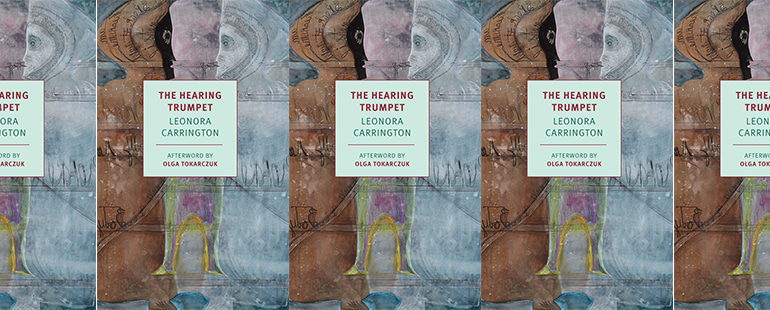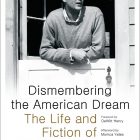The Hearing Trumpet by Leonora Carrington

The Hearing Trumpet
Leonora Carrington
New York Review Books | January 5, 2021
As the Nazis invaded France, Leonora Carrington suffered a mental breakdown. The German Army had sent her lover—the Surrealist artist Max Ernst—to a concentration camp, and a friend convinced Carrington that she should flee to avoid detainment. Traveling from France to Spain by car, Carrington experienced a wave of psychosis: “I was the car. The car had jammed on account of me . . . I was horrified by my own power.” In Madrid, her state worsened, and she was admitted to an asylum. Upon release, her parents intended to send her to a sanatorium in South Africa, but Carrington escaped to Mexico, where she lived the rest of her life. We should be grateful: her institutional evasion led to some of her most interesting work. Carrington’s paintings and writings from this time often emphasized her eccentric relationship with reality, wedding magical realism and memoir, femininity and mythology, isolation and collectivism. In The Hearing Trumpet, Carrington leans into her starkest eccentricities, depicting the subversive power of womanhood with more imaginative zeal than almost any other 20th century novelist.
Marian Leatherby, the novel’s narrator, is a ninety-two-year-old woman who lives with her son and his family. When Marian’s friend and neighbor, Carmella, gifts her a hearing trumpet—a device that allows Marian to eavesdrop on faraway conversations—she overhears her family’s plot to institutionalize her. “Grandmother . . . can hardly be classified as a human being,” complains her grandson. Her daughter-in-law adds that Marian “does not have feelings like you or I . . . [she] is senile.” When a devastated Marian informs Carmella that she is to be sent away, Carmella devises a preemptive escape plan: “Institutions, in fact, are not allowed to like anything . . . in case they lock you in a tenth-storey room, you could take a lot of those ropes you weave and escape. I could be waiting down below with a machine gun and an automobile.”
Much of Carrington’s humor follows this formula: a banal setup with an absurd punchline, or vice versa. But Marian and Carmella’s humor also emanates from their rejection of the rational world—and the rational world’s rejection of them. Unapologetically idiosyncratic, their peculiarities consistently clash with their surroundings, which is why their eccentrics are so intimately linked with age. As Olga Tokarczuk notes in the novel’s Afterward, “old age is actually the only time in life when we can finally be ourselves, without worrying about the demands of others or conforming to the social norms that we have been constantly instructed to follow.” By populating The Hearing Trumpet with eccentric old women, Carrington explores what Simone de Beauvoir called “the fundamental source of women’s oppression,” i.e., the historical, social, and institutional othering of female bodies that precludes any genuine expression of individuality.
Marian’s family indeed unloads her to a pseudo-Christian and psycho-pedagogical women’s facility run by “Sanctified Psychologist” Dr. Gambit and his wife. The Gambits stifle the residents’ personal freedoms and enforce vague spiritual strictures that involve self-erasure and emotional submission. Like most of the novel’s non-elderly female characters, Gambit is parodically rendered, a clear derision of capitalist moral authorities. The real lifeblood of the Institute is the eclectic mix of elderly residents who host mysterious gatherings, engage with the supernatural, and possess secrets Marian seeks to uncover. Architecturally, the Institute’s living quarters are configured into surrealist forms: a boot, an Egyptian mummy, a Swiss chalet. For Marian, however, the Institute’s most puzzling feature is a portrait of a winking nun hanging from the cafeteria wall. Christabel, a Black housekeeper, notices Marian’s interest and lends her a book about the nun.
Thus begins the novel’s quixotic descent. For over thirty pages, a Nabokovian narrator canonizes the life and times of Rosalinda Alvarez della Cueva, Abbess of the Convent of Saint Barbara of Tartarus. The text within a text is rich in esoteric references and mythology, serving as both an adventure narrative and critique of Christian patriarchy. The foray into the Abbess’s history will come across as either head-scratchingly strange or delightfully inventive depending on your appetite (or lack thereof) for linear plots and smoking guns. When the reader—and Marian—completes the Abbess’s narrative, the novel’s relationship with realism further detonates into a string of fantastical events. Marian and the other residents stage a hunger strike after potentially witnessing a murder. The strike inflates the women with a collective strength and reconfigures the Institute’s power dynamics. One resident, lambasting the Gambits, articulates this shift: “Do you imagine in your wildest dreams that now we have tasted freedom we are going to let ourselves be pushed around by you and your leering mate?”
Here’s what transpires in the wake of this newfound freedom: Marian encounters a twin version of herself, whom she eats in a stew. An ice age befalls the earth and Carmella prays that all men “freeze to death. I am sure it would be very pleasant and healthy for human beings to have no authority.” Amid this environmental apocalypse, a postman travels to the Institute and informs the surviving women that he possesses resolutory intelligence about the Abbess. These events unfold in a bizarre haste, yet Carrington somehow shoehorns the madness into a slew of intriguing philosophical questions: Is reality malleable? From where do our moral foundations arise? How can we transcend repressive power structures, and what would our lives look like without them? To be sure, The Hearing Trumpet issues nothing in the way of answers. The novel eludes any whiff of definitiveness, instead layering ideas and questions atop one another like blocks in a Jenga tower. Naturally, Carrington forces the reader to withdraw the first block.
The Hearing Trumpet is a tremendously weird novel that revels in inconclusive ideas, surreal reimaginings, and the peculiarities of human consciousness. While the deluge of mythology and allusion can occasionally inhibit an otherwise pleasurable reading experience, The Hearing Trumpet’s singular, provocative perspective provides a vivid glimpse into Leonora Carrington’s invaluably frenetic mind.



